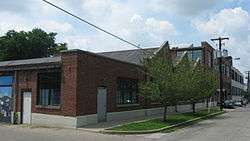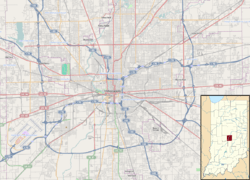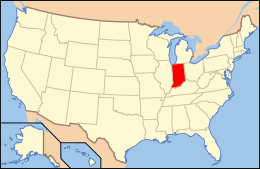Wheeler–Schebler Carburetor Company
The Wheeler–Schebler Carburetor Company was one of the Indianapolis's most important auto parts manufacturers and the last automobile parts factories in Indianapolis, Indiana to survive from the first decades of the 20th century. The Wheeler–Schebler Carburetor Company Building was the company's original building at the Barth Avenue site.[3] It was added to the National Register of Historic Places in 2004.
| Industry | Manufacturing |
|---|---|
| Successor | Borg-Warner Corporation |
| Founded | 1902 |
| Founder | Frank H. Wheeler[1] George Schebler |
| Defunct | 1912 (Evolving) 1987 (closed) |
| Headquarters | Indianapolis, Indiana, United States |
| Products | Carburetor |
| Owner | Frank H. Wheeler |
Wheeler–Schebler Carburetor Company Building | |
 | |
   | |
| Location | 1234 Barth Ave., Indianapolis, Indiana |
| Coordinates | 39°45′0″N 86°8′28″W |
| Area | 1.25 acres (0.51 ha) |
| Built | 1911-12, 1919-20, 1928 |
| Architect | Bohlen & Sons; Herbert L. Bass |
| NRHP reference No. | 04000210[2] |
| Added to NRHP | March 22, 2004 |
History
In 1904, Harry C. Stutz, who was involved in the design and manufacture of internal combustion engines, introduced George Schebler to Frank W. Wheeler. In the resulting partnership, Wheeler provided the money, while Schebler provided the engineering skills. Stutz worked temporarily as Sales Manager. By 1907, they had achieved enough success to move to Indianapolis into a state-of-the-art factory, reportedly one of the most advanced in the United States at the time. It produced carburetors for over 15 makes of autos from 1911 up to 1951.
Frank Wheeler and three other local men opened the Indianapolis Motor Speedway in 1909. Prior to the inauguration of the Indianapolis 500 in 1911, the Wheeler-Schebler company sponsored the Wheeler-Schebler Trophy Race at the track. George Schebler sold his interests in the company in 1912, but it continued to operate under the Wheeler-Schebler name until 1928, when it evolved into the Marvel-Schebler Carburetor Company, one of five companies that played a role in the development of what became Borg-Warner Corporation.
The Marvel-Schebler company did some of the early work on fuel injection systems in the late 1950s and early 60s, eventually merging with the Tillotson Carburetor Company in 1971. In 1985, the name was revised to "Control Systems" by the parent company, Borg-Warner. When Borg-Warner went through a leveraged buyout in 1987, Borg Warner Automotive Inc. was spun off as an independent company that is still in operation, developing fuel efficient engine and drive train technology. To this day, the trophy awarded annually to the winner of the Indianapolis 500 is known as the Borg-Warner Trophy.
The original Wheeler-Schebler building still survives. It used to house the "Wheeler Arts Community" and the "Community Arts and Education Center" in the Fountain Square district of Indianapolis at 1035 East Sanders Street until it was closed in 2018.[4] The building is now being converted into market-rate housing units.
References
- Stokely Mansion. Historic Campus Architecture Project, retrieved 20 October 2011
- "National Register Information System". National Register of Historic Places. National Park Service. March 13, 2009.
- "Indiana State Historic Architectural and Archaeological Research Database (SHAARD)" (Searchable database). Department of Natural Resources, Division of Historic Preservation and Archaeology. Retrieved 2016-08-01. Note: This includes Alan Conant (February 2003). "National Register of Historic Places Inventory Nomination Form: Wheeler–Schebler Carburetor Company Building" (PDF). Retrieved 2016-08-01.
- Olson, Scott. "Under new owner, Fountain Square's Wheeler building converting to market-rate housing". Indianapolis Business Journal. Retrieved 7 February 2020.

